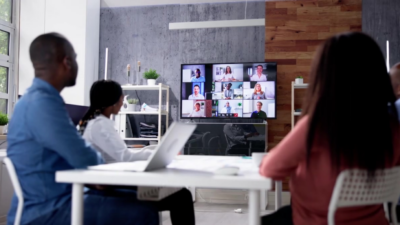In today’s competitive and fast-paced business climate, creating effective, future-focused workplaces is essential. To attract and retain top talent, especially those with the hard and soft skills shaping the U.S.’s most multigenerational and culturally-diverse workforce, companies must use forward-thinking workplace design to move the needle in their favor.
The workplace is not only the bedrock for an organization’s vision, aspirations and brand expression, but should also be used strategically to form a better experience for employees and business clients alike.
In this two-part series, we have outlined four specific attributes of the most innovative workplaces:
- Purpose
- Flexibility
- Elasticity
- Technology and Visualization
These characteristics are more than trends — they are staples of good workplace strategy and provide touchpoints for companies to iterate and evolve the workplace to align future technologies, design drivers and the level of investment, while also appealing to high-performing workers.
Purpose
With the advent of the gig economy and the rise of coworking, workers are increasingly comfortable changing jobs more frequently or taking a pay cut, as compared to previous generations. Employees are choosing to work with organizations where they feel empowered to make an impact, where they believe in the benefit of the product or service and where they can benefit from a positive work culture. Talented people are choosing to work for purpose-driven companies.
Social enterprise, sometimes called “conscious capitalism,” is also becoming a factor in attracting and retaining the best talent, as many employees desire to be part of something bigger and leverage company resources as a platform for change in their own communities and beyond. Even consumers are increasingly shifting their spending habits to align with products and services where a portion of the profits are donated to good causes. This further inspires employees to be proud of their work and their organization.
While in the past, real estate decisions were focused mainly on efficiency and cost savings, now decisions are shifting towards a more human-centric design, with an emphasis on creating an environment where workers can thrive and is based on the premise that if it’s good for the people, it’s good for the business as well. This shift makes sense considering real estate and the operations of these spaces are about 10% of a business’s total spend, while the spend on people is over 80%. Scrimping on real estate at the hindrance of your employees is not a good business decision.
Going beyond the function of space to support critical business needs, innovative companies are creating places for their employees to achieve privacy and deep focus, while optimizing the in-between times by creating spatial opportunities for collaboration, community and play. The workplace can also be restorative for its workers. Many companies not only provide a balance between open and closed spaces, but also think about sustainability and employee wellbeing through ergonomics, natural light, indoor greenery, access to healthy food options, stress-reduction with mindfulness spaces and destination strategies that get people up and moving. Some offices even employ advanced biophilic strategies like indoor circadian lighting that replicates the natural rhythms and colors of the sun.
The most innovative offices are more than just a place. They are the alignment of technology, culture, values, wellbeing initiatives, HR enablement and brand expression, with deliberate efforts to support behaviors that drive the mission of the organization. Garage-based startups can provide a great work environment, while some offices with beautiful spaces create a toxic work environment because of disorganized policies and culture. Companies need to align their environments with the purpose of their organization.
Flexibility
Whether it is when we work, where we work, whom we work with or the tools we use, having variety, choice and resources to adapt is the flexibility that makes the workplace innovative and successful for employees. Technology is a major driver transforming the way we work and flexibility within that context can be defined in many ways.
While location of the office is very important, when seeking new opportunities, employees are happier when they can balance their work and personal lives. As a result, some of the most sought-after benefits include flexible hours, the ability to work remotely and access to the latest devices and technology.
The most innovative companies are rethinking the workplace to better optimize the face-to-face connections that happen when their employees come together. Whether space is optimized to allow for more team building, collaborative group work or knowledge sharing, more multipurpose, alternative settings are being created to enable a myriad of tasks that are best suited to be done in the office.
Flexibility in action is building a dynamic workplace that balances both individual and group work, open and enclosed spaces, and technology tools that optimize efficacy and a desire to use space more flexibly. Most importantly, leaders must model the desired space-use behaviors to “give permission” to use these spaces and empower employees to make conscious decisions around where they will work best given the task at hand.
The adage “location, location, location” is continuing to break down. The biggest cities — New York, Chicago, Boston and San Francisco — are increasingly expensive and congested, so companies are looking to second-tier cities to build new locations. More affordable cities like Detroit, Salt Lake City and Kansas City are becoming popular locations because they offer more affordable housing, easier commutes, strong city infrastructure and good schools.
Environmental factors such as walkability, access to area amenities, public transportation and cost of living continue to be important considerations in workplace location decisions and the most innovative companies seek out accessible social centers to enrich employee’s lives outside of the office.
Purpose and flexibility are only two of the workplace innovation factors to consider. In the second part of our series on innovative workplaces, we’ll explore how elasticity, technology and visualization contribute to the most innovative environments.
About the Author
Michelle Cleverdon leads the western region on behalf of the Colliers’ Workplace Consulting team. With a passion for developing transformational strategies, she is focused on the meaningful connection between people, technology and the work environment.
Contributors
Keith leads the Workplace Consulting practice for Colliers International in the Americas. His team helps create environments that engage employees, drive culture, promote wellness and enable productivity leading to competitive advantage.
Kate is a senior leader within the Workplace Consulting practice at Colliers International and is a globally recognized thought-leader, speaker and author. With over 25 years of experience, Kate believes in “the power of place” and has witnessed “what’s possible” when the workplace is aligned with an organization’s culture and business goals.

 Michelle Cleverdon
Michelle Cleverdon Michelle Cleverdon
Michelle Cleverdon Keith Perske
Keith Perske Kate North
Kate North
 Anthony Shell
Anthony Shell
 Andrew Steele
Andrew Steele
 Aaron Jodka
Aaron Jodka